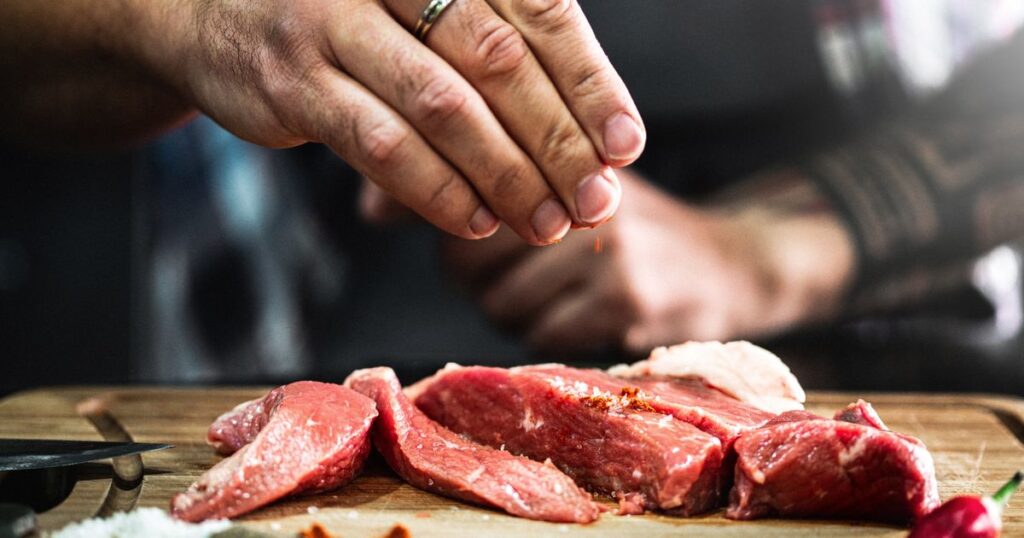🔴 Website 👉 https://u-s-news.com/
Telegram 👉 https://t.me/usnewscom_channel
When preparing raw meat, I’m careful; I wash my hands, use separate utensils and immediately put my cutting board in the dishwasher to prevent cross-contamination. But the same can’t be said for when I’m prepping veggies. Take potatoes, for example. After a quick rinse off of the starchy tuber slime, I’ll use the same knife to slice an apple or chop lettuce for a salad.
Chefs and food safety experts say this isn’t a good idea.
Cleaning surfaces, tools and produce are all key to staying safe, even when preparing an innocuous potato.
HuffPost spoke with food safety experts about how produce can cause food poisoning through cross-contamination and how to properly prepare fruits and vegetables.
Produce is commonly linked to foodborne illness.
Julian Bond, executive chef and vice president of the Pacific Institute of Culinary Arts, uses the potato, arguably the best vegetable, to help his cooking school students understand the nuances of food safety. He explained, “I ask my students who washes their cutting boards after chopping chicken, and everybody puts up their hand. I ask the same question about potatoes, and no one does.”
While we’re all aware of the dangers of raw and undercooked meat, fruits and vegetables have been the most commonly linked to foodborne illness in the United States. Recent outbreaks include leafy greens, strawberries, alfalfa sprouts and mushrooms, which can be caused by contaminated soil, water or even due to improper handling by workers. While contaminated produce is rare, outbreaks happen every year.
Bond said, “Here’s the scenario: You’re chopping potatoes that you haven’t washed properly, and you just wipe the board before going onto chop your chicken. It’s a breeding ground for bacteria and pathogens.”
What’s lingering on produce that could be dangerous?
Let’s follow Bond’s scenario to its full conclusion. What pathogens might lurk on the potato and then spread onto your knife and cutting board?
Donald Schaffner, food science department chair at Rutgers University, said, “The pathogenic microorganisms associated with raw potatoes would be any that are found in and survive in the dirt. The primary ones that I would be worried about would be spore-forming pathogens like Bacillus cereus, Clostridium botulinum, and Clostridium perfringens.” Yum.
Naturally found in soil or as a result of animal manure improperly composted, these pathogens can cause gastrointestinal upset and diarrhea. Luckily, you need to eat a lot of those pathogens to get sick, according to Schaffner. He explained, “The good news is that pathogens like Bacillus cereus and Clostridium perfringens are ‘high-dose’ pathogens that need to be ingested in relatively high numbers to cause illness. Generally, these high numbers only occur when the food supports the growth of these pathogens and conditions are right. Fortunately, raw potatoes are not a good food source for microorganisms.”
Dangerous and often deadly outbreaks like Salmonella, E. coli or Campylobacter are low-dose pathogens, meaning a little can cause infection. Romaine and bagged lettuce got a bad rep for recent outbreaks, but raw fruits and vegetables can also become contaminated. Proper cooking is the only way to kill these pathogens, according to Darin Detweiller, associate teaching professor at Northeastern University.
How often should you actually wash your cutting board and knives while cooking?
Before you ditch veggies and go on the carnivore diet, there are some simple steps to keep you and your family safe. Bond said, “Think of your fruits and veggies as delicate guests. Give them a gentle spa day under cold running water. Use your fingers or a soft brush to clean stubborn spots. No need for soap. Just let them enjoy the refreshing shower.” Washing produce can eliminate microorganisms and reduce the risk of cross-contamination, according to Schaffner.
Even fruits and veggies with a hard exterior peel should get a good rinse, according to Bond. The reason: Pathogens and bacteria can transfer from the peel onto your hands or cutting board. Bond said, “Even produce with tough skins like cantaloupe and citrus fruit need a good wash. Think about when you slice them. The knife can transfer bacteria from the skin to the edible part. So, show them all some love with a rinse.”
One major thing the pandemic has taught us is that we should wash our hands a lot more. “Always assume that [produce] could be covered with pathogens,” Detweiler said. “Wash your hands, even if you’re only using potatoes to make decorations or as stamps for paint in craft projects. Wash and scrub all produce before you cook them.”
Grab a separate and clean cutting board for ready-to-eat produce (like apples you snack on) to prevent cross-contamination. Schaffner said, “A best practice is to only prepare ready-to-eat chopped vegetables on a clean cutting board that had not previously contacted raw [produce].”
Support Free Journalism
Already contributed? Log in to hide these messages.
A wooden cutting board is Bond’s go-to. He said, “Wooden boards have natural antibacterial properties that can help keep your produce safer. Plus, they’re gentle on your knife blades, preserving their sharpness. Just remember to give them a thorough cleaning and drying after use to prevent any lingering germs from setting up camp.”
